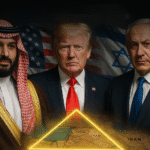The Strait of Hormuz, a narrow but strategically vital waterway situated between Oman and Iran, plays a crucial role in global energy security. It serves as the main passage for oil and gas exports from the Persian Gulf, making it one of the most important chokepoints in the world. About 20.5 million barrels of oil pass through the strait every day, representing roughly 30% of the world’s seaborne oil trade. Despite being only about 33 kilometers wide at its narrowest point, its economic and geopolitical importance far outweighs its size. Countries like Saudi Arabia, Iraq, the UAE, Kuwait, and Qatar all rely on this route to ship their oil and gas to international markets, especially in Asia and Europe.
The strait lies between Iran to the north and the Musandam Peninsula of Oman to the south. While both countries have coastlines along the strait, Iran exerts more influence over the waterway due to its military presence and strategic posturing. Iran’s Islamic Revolutionary Guard Corps (IRGC) regularly patrols the area, and Tehran has repeatedly asserted that it has the capability to control or even block the strait if provoked. On the other side, Oman has traditionally maintained a neutral stance and played the role of mediator during times of tension. The United States and its allies, recognizing the strait’s global significance, maintain a strong naval presence in the Persian Gulf. The U.S. Navy’s Fifth Fleet, based in Bahrain, is tasked with ensuring maritime security and safe passage for commercial vessels, particularly oil tankers.
Tensions in the region have surged several times over the past decade, with Iran often threatening to shut down the strait in response to Western sanctions or military actions. In recent months, the situation has again become volatile. In June 2024, Iranian officials warned that they might consider blocking the strait if the country’s sovereignty or economic interests were threatened, particularly in response to renewed U.S. sanctions and Israeli military actions in Syria. The Iranian Revolutionary Guard conducted several naval exercises near the strait, and satellite images showed an increased number of Iranian patrol vessels in the area. The U.S. Navy also reported drone flyovers and near-encounters with Iranian vessels, further escalating tensions.
Although Iran has never fully closed the Strait of Hormuz, even the suggestion of such a move has serious consequences. Markets are highly sensitive to instability in this region. In June 2024, crude oil prices surged nearly 7% in a single day following Iran’s warning and military movements near the strait. A complete closure would likely result in oil prices skyrocketing to over $150 per barrel, causing inflation and potential recession in multiple countries. Asian economies like Japan, South Korea, China, and India — all heavily reliant on Gulf oil — would be especially affected. Although alternative routes exist, such as pipelines through Saudi Arabia and the UAE, their capacity is limited and cannot fully replace the shipping volume of the strait.
The global response to Iranian threats has been swift and firm. The United States has declared that any attempt to obstruct the Strait of Hormuz would provoke a strong military reaction. European allies, including the United Kingdom and France, have also deployed additional naval assets to the Gulf region. Insurance costs for tankers passing through the strait have spiked, and several shipping companies have started rerouting vessels or delaying shipments out of caution.
As of June 2025, diplomatic efforts to calm the situation remain stalled. Iran’s nuclear activities have intensified, and talks to revive the 2015 nuclear deal have made little progress. The International Atomic Energy Agency (IAEA) has raised alarms about Iran’s uranium enrichment levels, while the U.S. has expanded sanctions targeting Iran’s energy and defense sectors. Oman, acting as a regional mediator, has called for restraint and offered to host negotiations, but no concrete steps have been taken. Meanwhile, international observers are closely monitoring the situation, aware that the strait remains a potential flashpoint that could spiral into a broader conflict.
The Strait of Hormuz is far more than just a narrow waterway — it is a strategic artery for the global economy. Any disruption to its functioning could trigger energy crises, economic instability, and even military conflict. The current tensions surrounding Iran and its control over this crucial passage serve as a stark reminder of how fragile global energy security can be in a region fraught with political instability and longstanding rivalries. As the world grapples with these uncertainties, maintaining open access to the strait remains a top priority for global peace and economic stability.












